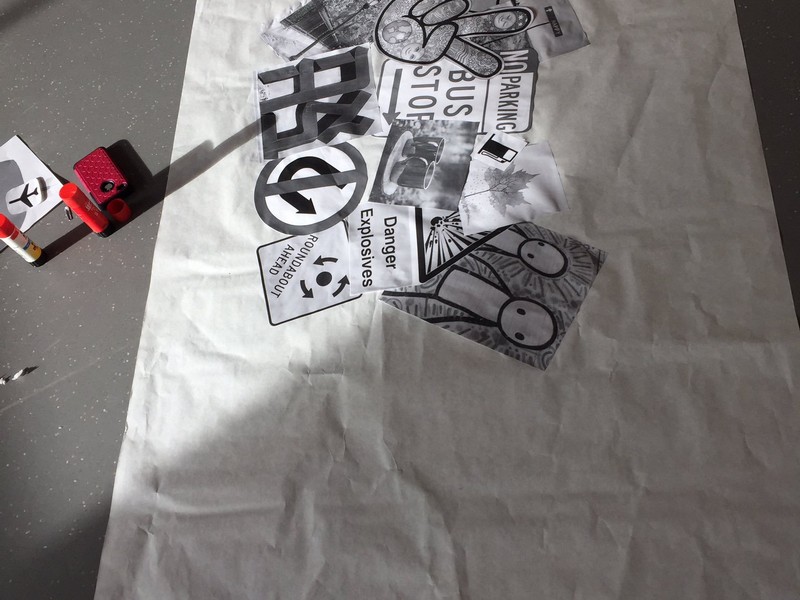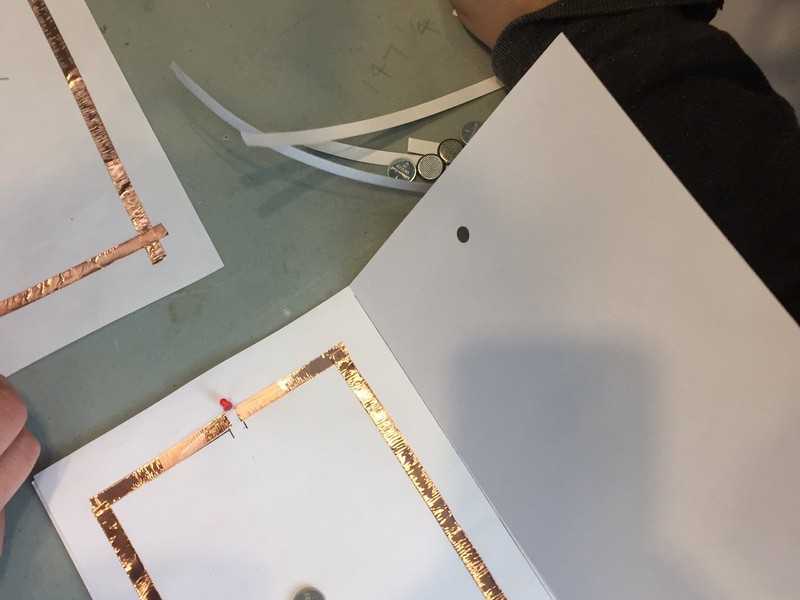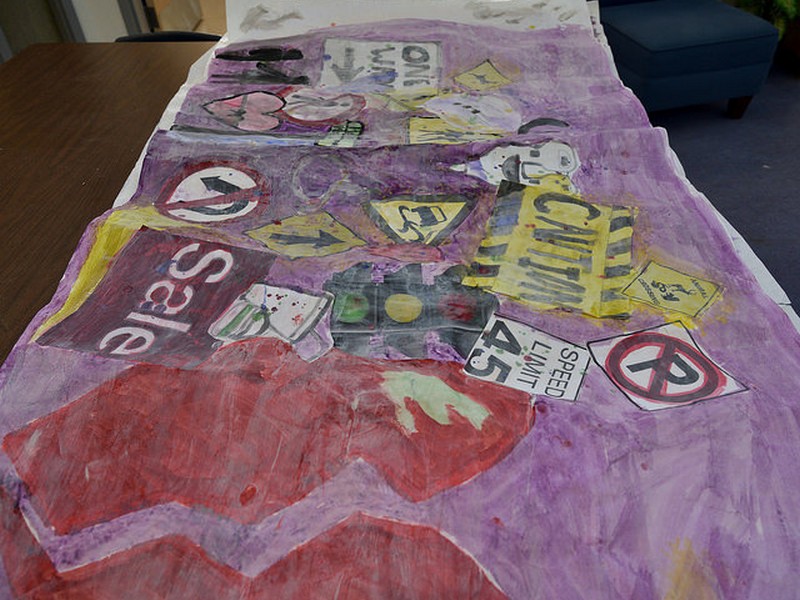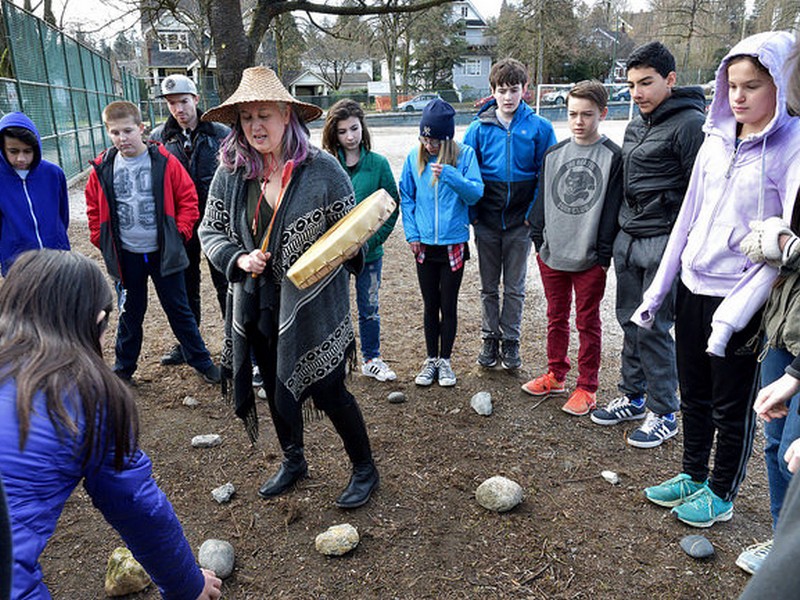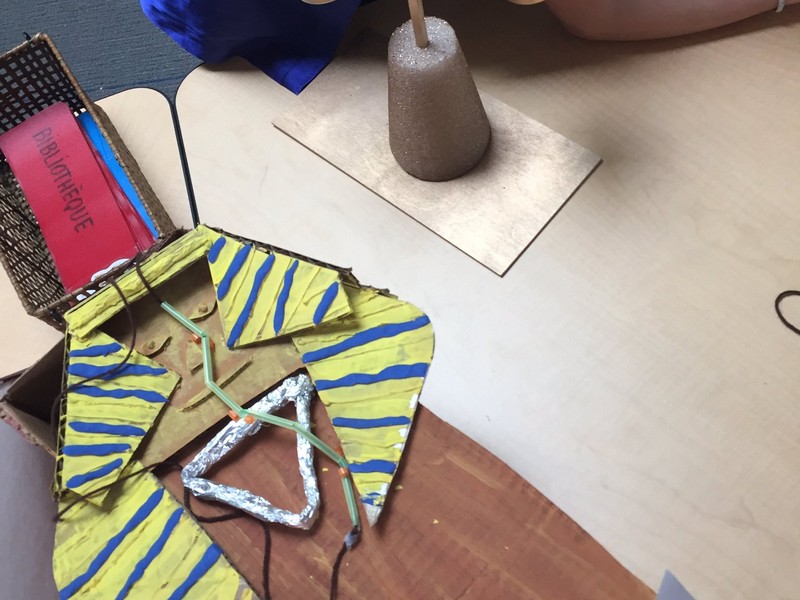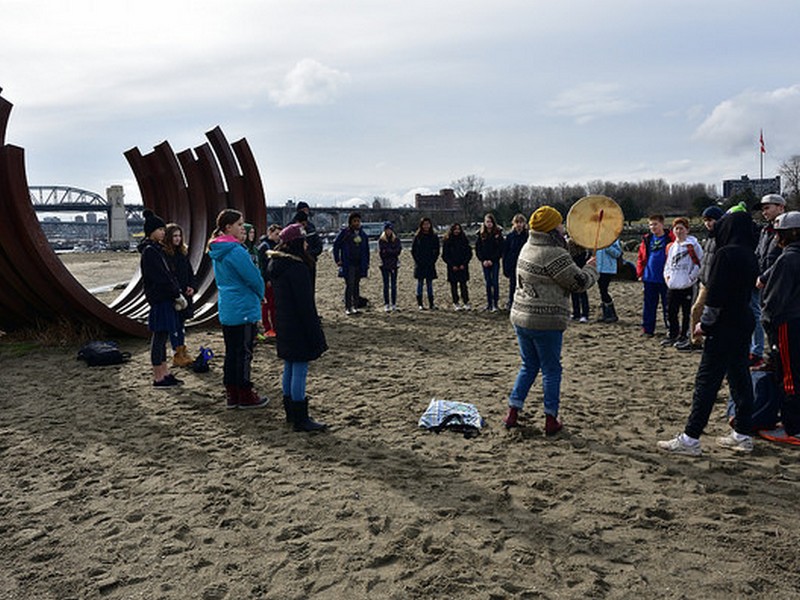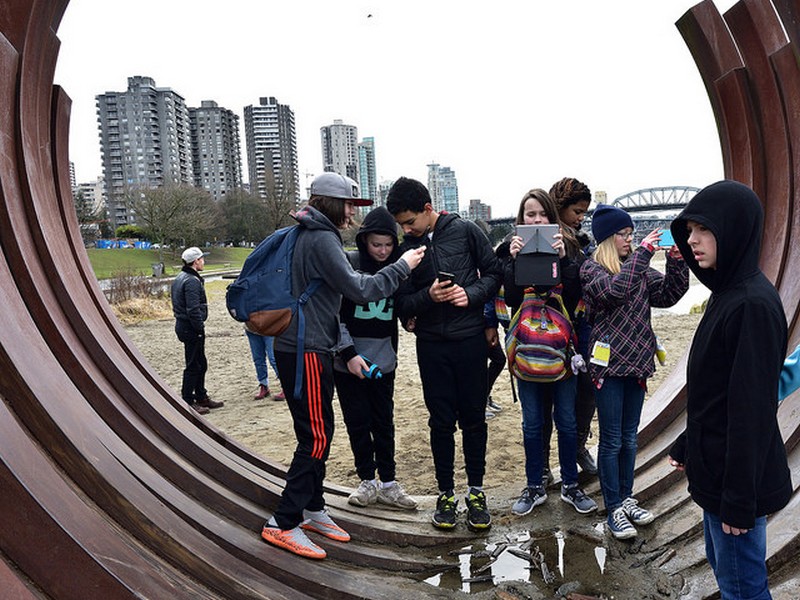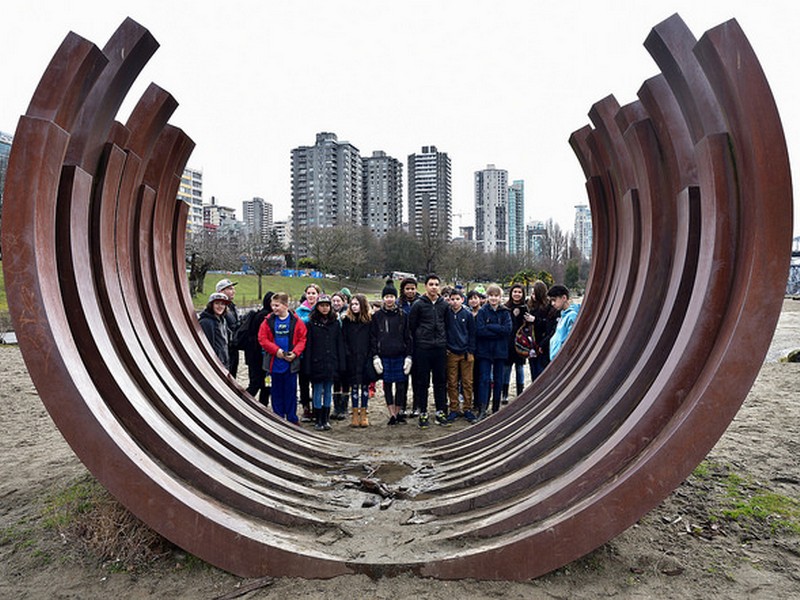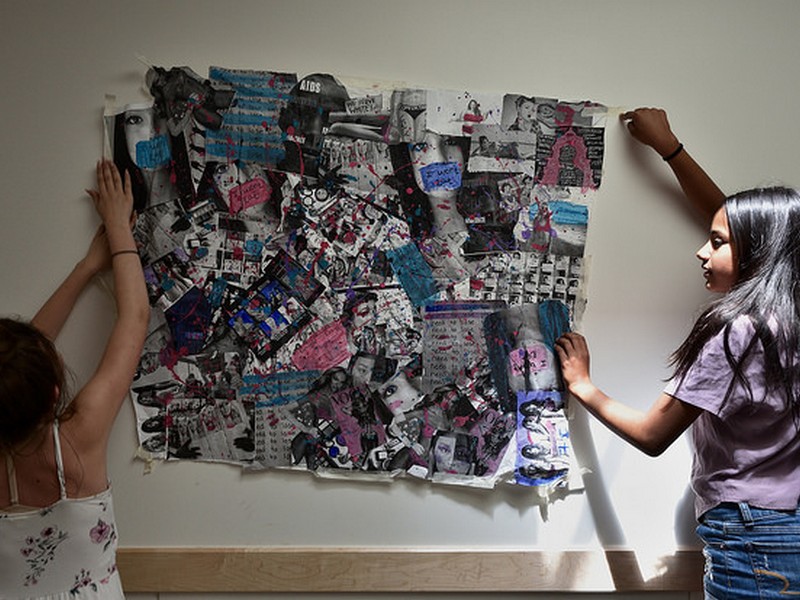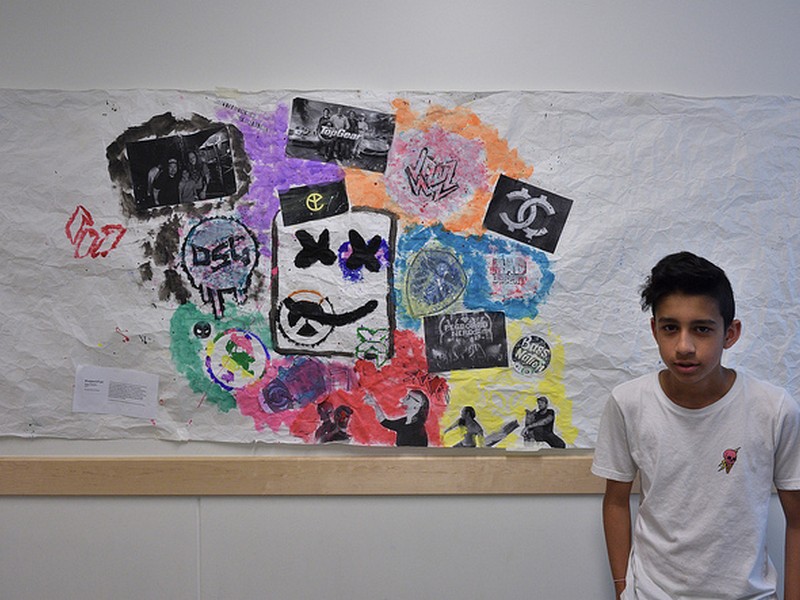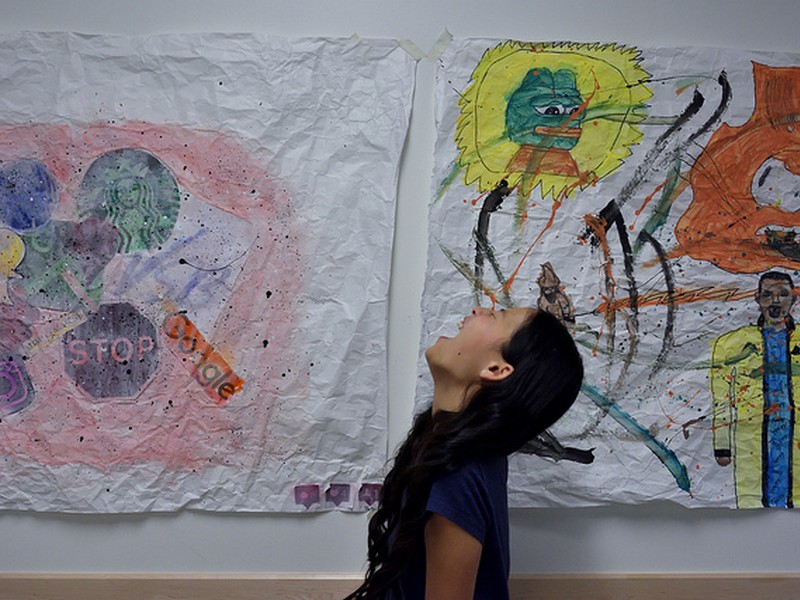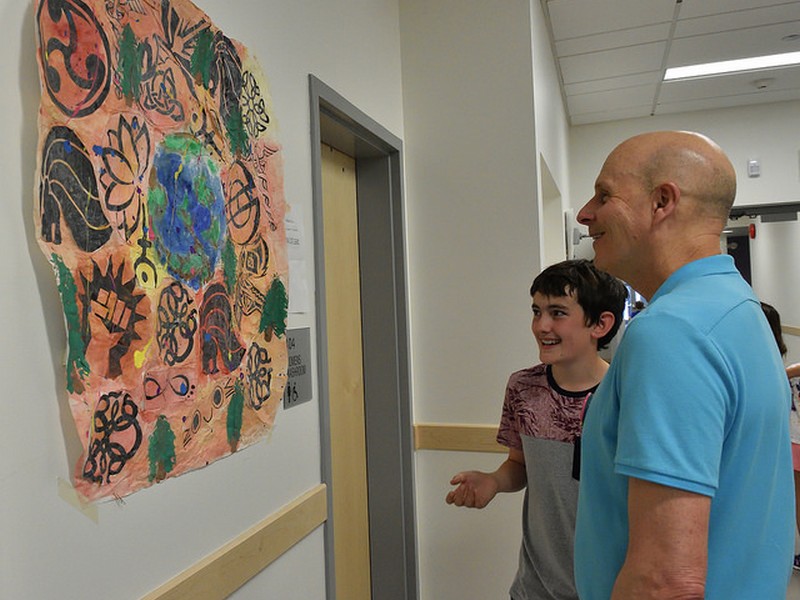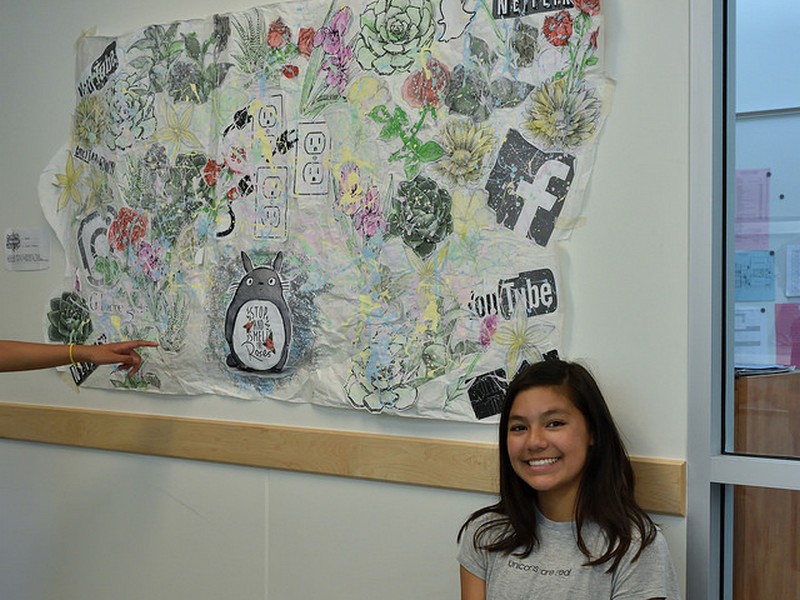École Bilingue: Balancing Symbols
Arts Education, Language Arts, Mathematics, Science, Social Studies
School: Ecole Bilingue Elementary
Teacher: Olivier Salvas
Artist Collaborators: Cease Wyss
Class: Grade 7
Overview
History has begun with the creation of what we can call the first symbol: writing, which included both letters, numbers and signs. Prior to the creation of writing, during prehistory, drawings have been used as symbols to represent a lifestyle. The new BC Curriculum focuses on literacy and mathematics, which are symbols. The revised curriculum also suggests the learning of coding, which also contains many symbols. The key inquiry concept of this Biennale project is go back to the roots of how these symbols have been created in the Ancient Civilizations and how their meaning have involved globally today. With this project, students explored how symbols can be expressed differently through nature, sounds and light. Students had an opportunity to engage in activities that allowed them to grow emotionally, socially and intellectually without premeditation.
Connection to the Vancouver Biennale Exhibition
The students visit the 217.5 Arc X 13 by Bernar Venet to investigate its connections to various geographical aspects such and the wind, the sand, the air, the water, the mountains, the city, the beach installations, etc as part of the experience of looking at the various possibilities of symbols around us.
The installation was viewed as a symbol with its arched shape and how its meaning can be interpreted could be endless due to its fluidity. The site of the installation in the West End and on the seawall leading to Stanley Park, the students were encouraged to look at it as a symbol or a way to see what perspective the diverse population (geology included) would take on it using the five senses.
The second inspiration for this project is Trans Am Totem by Marcus Bowcott. With its contras of the old and the new, it fits into the discussion during the study of the symbols created by the Ancient Civilizations and how these symbols are relevant today in our reality as citizens of Vancouver. The students were guided to inquire on: How we can see this installation as a symbol of Vancouver? What does it show? Is it all positive? Are all symbols positive? This will be a good time to look at the negative connotations to symbols and to see if we feel symbols that represent us only have to be positive. The Trans Am Totem title also sparked conversation and served as a bridge to the aboriginal aspect of the inquiry.
BIG IDEAS
Social Studies:
- Geographic conditions shaped the emergence of civilizations.
- Religious and cultural practices that emerged during this period have endured and continue to influence people.
Science:
- The theory of evolution by natural selection provides an explanation for the diversity and survival of living things.
- Earth and its climate have changed over geological time.
Language Arts:
- Exploring text and story helps us understand ourselves and make connections to others and to the world.
Mathematics:
- Linear relations can be represented in many connected ways to identify regularities and make generalizations.
- The constant ratio between the circumference and diameter of circles can be used to describe, measure, and compare spatial relationships.
Arts Education:
- Through art making, one’s sense of identity and community continually evolves.
- Dance, drama, music, and visual arts are each unique languages for creating and communicating.
Guiding Questions
How do symbols connect us locally and globally?
Inquiry Challenges
To begin the inquiry, the class went on a tour of the neighbourhood to find symbols. that help the students describe their generations. The main categories that were found by students that day were: connected, creative, busy, educated and mixed. Guided by T’uy’t’tanat, also known as Cease Wyss, a local aboriginal artist, the class visited 217.5 Arc X 13 by Bernar Venet, a Vancouver Biennale installation that inspired this inquiry, located at Second Beach, in Vancouver, BC. The class explored how this installation can be used as a symbol and what are some of the characteristics the installation has in common with the symbols from the Ancient Civilizations the students had previously explored at the Museum of Vancouver. The students used the installation to make connections with the Math curriculum, by using it to study the circle and to use it as the origin for a giant coordinate graph, using rocks to identify each quadrant, having to work together to make this living Math nature art around the installation. Students used their personal devices to record sounds used for a collective spoken word track. Some created sounds with the installation, while others recorded some of the sounds around them like the racing police cars, the seagulls and the sound of the ocean.
After inquiring about the patterns that are visible in our environment, the students decided to work on the school community garden, inspired by plants that had a symbolic meaning to them. The students came up with the task to create tools that would maintain the school garden. Some of the inventions included a waterwheel, a seed planter made with Lego Minsdstorms and a garden controller made with Arduino. The class visited the Haroon Mirza exhibition on Light and Sound at the Contemporary Art Gallery to explore different perspectives on symbols and to gather ideas for our inventions. Mirza has received international acclaim for work that tests the interplay and friction between sound and light waves and electric current.
For the last phase of the inquiry, the students embarked on their journey to create a mixed-media painting with three layers: a collage of pictures that represents symbols, splatter of paints to represent the emotions and a political statement on an element of the Generation Z in the style of a Graffiti art.The project culminated in a collective exhibition that represented one or multi symbols that represent student identity and their place in the world.
Learning Process and Timeline
As an educator, Oli believe the disconnect between the learner and the curriculum expands faster than before. It seems inevitable that students have to have a stronger input regarding the themes chosen in our curriculum. Oli finds that his students perform better when they are in a position when they understand the purpose of what they are doing. Curriculum, being the study of all educational phenomena, should put the students in a situation on unanticipated outcomes. As educators, Oli believes we need to value the importance of connecting what is happening in class to our society.
The curriculum becomes more of an exploration and a conversation to have more than something to learn. As students become more engaged into the conversation, they become more creative, therefore they work on their critical thinking skills. Since school work becomes some sort of works of art, students must defend their opinions yet be open minded to each other’s creations. Oli teaches based on students interests, feeling and thoughts and validating perspectives in a positive environment.
Part 1: January – What are symbols?
Exploring what we know and our local symbols
As a class, the students began their inquiry by finding items that defines us, while creating a vision board for the upcoming year, using only symbols. This was followed by a group conversation about what symbols are and how they can be defined.
The students completed self-regulation strategies and MindUp activities to discover the Five senses along with visual learning strategies to understand the connotation behind shapes and colours.
The class went on a tour of the neighborhood to look at potential symbols, using what we have found and learned so far with the previous activities.
After finding symbols that defines us and our community and as a class, the students reviewed the information and attempted to find the significance and connections of the findings.
The class looked for patterns among the symbols and created a mural using graffiti and collages, a collective painting with the symbols from the neighborhood. The inspiration of this creative process comes from the street artist Mr Brainwash.
The class visited Haroon Mirza exhibition on Light and Sound at the Contemporary Art Gallery which inspired the students to make LED cards while looking at different perspectives on symbols.
Perspectives on Symbols
The class explored how the 217.5 x 13 Arc by Bernar Venet can be used as a symbol and what are the characteristics of the installation has in common with the characteristics of the symbols they had found in the neighborhood. Mind Up and Self-Regulation technique was utilized to look at symbols that students made connection to the site using their Five Senses. The class looked at the geology around and see how the meaning of the installation can change its surroundings.
As part of the cross-curricular study of Math, the class considered how to measure the space of the installation and the space around it in order to create a replica in class.
A visit was made to the Barclay Roedde House to look at artifacts from the early days of Vancouver and to look for more symbols. The students gained perspective from people of the past on their symbols and how they can connect with symbols of today. The students inquired into how might the people living in the Roedde House relate to the 217.5 x 13 Arc?
In class, students used the installation and transformed it into a symbol that represent them right now and transformed it using other perspectives. Students documented their findings on their online portfolio and did a compare and contract text (audio, image, video…) of the different perspectives covered that day.
Images in Literature
After covering the five senses and nature element, the class explored imagery in French Canadian poetry, short stories and legend (including French Canadian Aboriginal stories) to see if figurative elements can be used as symbols linked to our inquiry. How can these symbols improve the comprehension of the story? Do they have an impact on the character? On his/her identity?
The students looked at the different symbols that are present in literature such as writing, printing, images, etc.
Symbols in Mathematics
The class went through various inquiry activities on patterning and symbols. The students asked themselves if patterns are visible in their environment. Did patterning have an influence on man-created symbols? What is the aboriginal perspective on Mathematics? (Reading the book Small number and the Old Canoe). The students spent time in the nature and create explore patterns with nature and see how some first technologies has to do with mathematical patterns)
Symbols in the Diversity of Life
The class made a visit to the Stanley Park and looked at our own diversity of life. The students took pictures of the diversity of life to create a collage with photography applications. Upon return to school, the students organized their findings into categories (animals, plants, etc.) and discussed their common characteristics and identify their species.
Further research on the symbolism of two selected elements of the diversity of life was conducted using the guiding questions – Do all elements of the diversity of live symbolic to one thing or another? What is the difference between something that symbolic or something that has a meaning or a traditional meaning?
Part II: The First Symbols
Stepping Back in time
The class looked at what possibly could be considered the first symbols according to the Ancient Civilizations. What are the similarities and the differences between the symbols of each civilization?
Students read novel studies on the life in Ancient Civilization in French Language Arts and used them to find clues about possible symbols of the Byzantine, Greek, Roman, Chinese, Mesopotamian and Egyptian civilizations. Students illustrated the symbols in a book of symbols and wrote poetry to represent these symbols in the form of calligrams. Students illustrated symbols from Ancient Egypt by creating sketches inspired by the Book of the Dead.
The Writing System
The class looked at how the first writing systems function and how these systems had evolved today. Guiding questions for this inquiry: Is writing the most important technology in modern history? Compare using other technologies that came from the past civilizations to justify your answer. What is the impact on language of increased trade and interactions between civilizations and trade? How are these first inventions represented in our society? Have they become symbols of their own?
Through writing, the students learned about rap music and its influence in today’s literacy. Students recreated hip hop dances to go with their own raps. We will study patterns in music at the same time. Do you know more symbolic music?
Mathematics in the Ancient Civilizations
The class looked at the mathematics in the ancient civilization and examined if there are patterns within them. The students also looked at patterns and the concept of balance using algebraic equations. This activity is linked to the rhythm activity.
Spiritual Symbols
The class looked at the origins, core beliefs, narratives, practices, and influences of religions in the Ancient Civilization and examined if artifacts, objects or people (Gods included) have become symbols in their society. Have these symbols carried through our society? How about globally? How have religion and spirituality evolved on the territories on the Ancient Civilizations compared to ours?
With this activity, the class acted plays on Greek/Roman mythology such as the ceremony of the dead on Egypt and inquired into what symbols they can find. Through the concept of balance with the feather and the heart, the students made connection with mathematics. Have the symbols of heart and feather carried through history? Globally? How is nature represented in the Ancient Civilization throughout spirituality? How is it symbolic?
In support of these learning activities, field trips were made to the Vancouver Museum Ancient Civilization Gallery and a tour of Chinatown. How are these symbols related to the ARC?
People as symbols
Can people become symbols? If so, how do we recognize them?
Who were some of the iconic figures in the Ancient Civilizations that remained today? What did they represent?
Has there been people throughout society that have become symbols? Can we make connections to the Ancient world? Can we categorize these people? Can people have different symbolisms according to the place they live in the world? Who are people that are symbolic in other countries? Continents?
At the end of the activity, students recreated a portrait of someone they find symbolic on a global stance in the style of Andy Warhol. Their portraits were done in a reproduction style, using stamping process and linoleum. As a literacy connection, students recorded a short audio file to make the art come to life.
Part 3: Locally VS Globally
Aboriginal PERSPECTIVES
The class went to the anthropology museum to attend the exhibition UNFOLDING CLOTH ACROSS CULTURES http://moa.ubc.ca/portfolio_page/layers-of-influence/
From birth to death, humans are wrapped in cloth worn for survival, but more importantly, wear clothing as an external expression of their spiritual belief system, social status and political identity. This stunning exhibition will explore clothing’s inherent evidence of human ingenuity, creativity and skill, drawing from MOA’s textile collection — the largest collection in Western Canada — to display a global range of materials, production techniques and adornments across different cultures and time frames.
Curated by Dr. Jennifer Kramer (MOA Curator, Pacific Northwest), Layers of Influence will entrance MOA visitors with large swaths of intricate textiles often worn to enhance the wearer’s prestige, power and spiritual connection, including Japanese kimonos, Indian saris, Indonesian sarongs, West African adinkra, adire and kente cloth, South Pacific barkcloth, Chinese Qing dynasty robes, Indigenous Northwest coast blankets, Maori feather cloaks and more.
A sumptuous feast for the eyes, the exhibition is an aesthetic and affective examination of humanity’s multifaceted and complex history with cloth and its ability to amplify the social, political and spiritual influence of the wearer as a functional expression of self-identity.
With this activity, the class made connections with the Ancient Civilizations and observe symbols linked to the aboriginal cultures.
Literature
The class studied the novel Touching Spirit Bear in English class. Throughout the novel, the class looked at symbols through the following questions:
Why does the Aboriginal People’s philosophy and approach involve circles? (Looking at the circumference of the circle at the same time in Math to make connections)
What is the significance of the spirit bear in the novel? In aboriginal cultures? In British-Columbia?
The class continued our literary inquiry by comparing this novel to other aboriginal novels such as Diary of a Part-Time Indian, Tales of Vancouver, 7 Generations, A Boy Called Slow, plus more from the recommended list from the Strong Nations website.
The students wrote blogs to report on their understanding of all novels.
The class also completed the activities called WE ARE CANADA from the WE Day organization, which are based on aboriginal issues and the reconciliation. https://www.we.ca/
Technology/Coding/Writing
The class reviewed the installation Trans Am Totem by Marcus Bowcott . What does it show? Is it all positive? Are all symbols positive? This will be a good time to look at the negative connotations to symbols and to see if we feel symbols that represent us only have to be positive. Can old and new symbols be merged? Do all symbols have to be positive? What should symbols represent? Is it ok to acknowledge negative moment sin history through symbols?
Students then worked with today’s symbols using coding applications such as making a movie using scratch, a slow motion video, or creating a website. The students learned to represent the past using new technologies and symbols.
Many inquiry activities were added to learn to work different coding programs and robotics programs such as Lego Mindstorm and Minecraft Education.
Pen Pall and Information Seeking
As conclusion of the project, the class wrote letters to a school in a francophone country, to their pen pals in Quebec and to an aboriginal school to ask questions about their findings on symbols and to see their perspectives on them.
Through the WE Day activities, the students chose countries they wanted to research more about and examined how symbols influence their lives.
Student Creation
As described in the learning process above.
Credits
The learning case was based on an artography book called “Rebel with a Cause” written by Olivier Salvas for his Master of Education in Media & Technology Studies degree thesis at UBC. The book focuses on student identity and on teacher identity within the school system.
